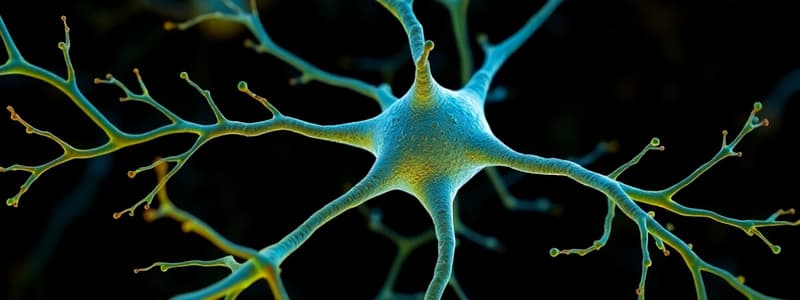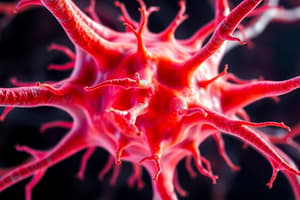Podcast
Questions and Answers
Which of the following accurately describes the relationship between the Neuron Doctrine and the Law of Dynamic Polarization?
Which of the following accurately describes the relationship between the Neuron Doctrine and the Law of Dynamic Polarization?
- The Neuron Doctrine explains how neurons communicate, while the Law of Dynamic Polarization explains how neurons are structured.
- The Neuron Doctrine states that neurons are the basic unit of the nervous system, while the Law of Dynamic Polarization describes the direction of information flow within a neuron. (correct)
- The Neuron Doctrine and the Law of Dynamic Polarization are unrelated concepts, each addressing different aspects of neuron function.
- The Neuron Doctrine and the Law of Dynamic Polarization are essentially the same concept, both describing the unidirectional flow of information within a neuron.
What is the defining characteristic that distinguishes interneurons from sensory or motor neurons?
What is the defining characteristic that distinguishes interneurons from sensory or motor neurons?
- Interneurons primarily transmit signals within the central nervous system, while sensory and motor neurons transmit signals to and from the central nervous system. (correct)
- Interneurons are responsible for processing information, while sensory and motor neurons are responsible for receiving and sending information.
- Interneurons have a smaller cell body than sensory or motor neurons.
- Interneurons only communicate with other interneurons, while sensory and motor neurons communicate with both interneurons and other neurons.
Which of the following is NOT a key component of the cytoskeleton?
Which of the following is NOT a key component of the cytoskeleton?
- Microtubules
- Microfilaments
- Intermediate filaments
- Phospholipids (correct)
What type of transport mechanism requires energy to move substances across the plasma membrane?
What type of transport mechanism requires energy to move substances across the plasma membrane?
How does increasing the conductance (number of open channels) for potassium ions (K+) impact the resting membrane potential (Vm)?
How does increasing the conductance (number of open channels) for potassium ions (K+) impact the resting membrane potential (Vm)?
What is the primary mechanism by which calcium channel blockers treat multiple sclerosis (MS)?
What is the primary mechanism by which calcium channel blockers treat multiple sclerosis (MS)?
In the context of synaptic transmission, which of the following best describes the role of the SNARE complex?
In the context of synaptic transmission, which of the following best describes the role of the SNARE complex?
How does the action of botulinum toxin (BoTox) at the neuromuscular junction (NMJ) differ from myasthenia gravis?
How does the action of botulinum toxin (BoTox) at the neuromuscular junction (NMJ) differ from myasthenia gravis?
Which of the following factors contributes to the 'all-or-none' nature of an action potential (AP)?
Which of the following factors contributes to the 'all-or-none' nature of an action potential (AP)?
How can the same neurotransmitter have both excitatory and inhibitory effects?
How can the same neurotransmitter have both excitatory and inhibitory effects?
What is the primary role of the amygdala in memory formation?
What is the primary role of the amygdala in memory formation?
Which type of memory is primarily associated with the striatum of the basal ganglia?
Which type of memory is primarily associated with the striatum of the basal ganglia?
What is the primary difference between AMPA and NMDA receptors in terms of their activation?
What is the primary difference between AMPA and NMDA receptors in terms of their activation?
Which of the following is NOT a characteristic of long-term potentiation (LTP)?
Which of the following is NOT a characteristic of long-term potentiation (LTP)?
Which of the following statements BEST describes the relationship between the hippocampus and the basal ganglia in memory formation?
Which of the following statements BEST describes the relationship between the hippocampus and the basal ganglia in memory formation?
What is the primary difference between anterograde and retrograde amnesia?
What is the primary difference between anterograde and retrograde amnesia?
Which type of memory is MOST susceptible to disruption by a blow to the head?
Which type of memory is MOST susceptible to disruption by a blow to the head?
Which brain structure is MOST likely to be damaged in individuals with Korsakoff's syndrome?
Which brain structure is MOST likely to be damaged in individuals with Korsakoff's syndrome?
Flashcards
Neuron Structure
Neuron Structure
Neurons consist of axons, dendrites, soma, and synaptic terminals.
Axon vs Dendrite
Axon vs Dendrite
Axons transmit signals away from the neuron, while dendrites receive signals from other neurons.
Presynaptic vs Postsynaptic Neuron
Presynaptic vs Postsynaptic Neuron
Presynaptic neurons send signals, while postsynaptic neurons receive them at the synapse.
Law of Dynamic Polarization
Law of Dynamic Polarization
Signup and view all the flashcards
Active vs Passive Transport
Active vs Passive Transport
Signup and view all the flashcards
Action Potential (AP)
Action Potential (AP)
Signup and view all the flashcards
Agonist vs. Antagonist
Agonist vs. Antagonist
Signup and view all the flashcards
Endogenous vs. Exogenous
Endogenous vs. Exogenous
Signup and view all the flashcards
Neuromuscular Junction (NMJ)
Neuromuscular Junction (NMJ)
Signup and view all the flashcards
Ca2+ in Synaptic Transmission
Ca2+ in Synaptic Transmission
Signup and view all the flashcards
Learning
Learning
Signup and view all the flashcards
Memory
Memory
Signup and view all the flashcards
Classical Conditioning
Classical Conditioning
Signup and view all the flashcards
Unconditioned Stimulus
Unconditioned Stimulus
Signup and view all the flashcards
Hippocampus
Hippocampus
Signup and view all the flashcards
Anterograde Amnesia
Anterograde Amnesia
Signup and view all the flashcards
Procedural Memory
Procedural Memory
Signup and view all the flashcards
LTP (Long-Term Potentiation)
LTP (Long-Term Potentiation)
Signup and view all the flashcards
Study Notes
Lecture 1: History and Intro to Neurons
- Definitions:
- Trephination: Practice of drilling holes in the skull
- Phrenology: Study of the skull's surface to determine personality
- Equipotentiality: Idea that all parts of the brain have equal potential.
- Golgi staining: Technique to visualize neurons
- Synapse: Junction between two neurons
- Nucleus: Control center of a cell
- Ribosomes: Involved in protein synthesis
- Cell Theory: Living things are composed of cells
- Neuron Doctrine: Neurons are the basic units of the nervous system
- Neurons:
- Axon, dendrite, soma, synaptic terminal
- Law of Dynamic Polarization: Neuronal information flows in one direction.
- Sensory, Motor, Interneurons: Classification of neurons
- Presynaptic vs Postsynaptic neurons: Neuron before and after the synapse.
- Neuron and glial cells
- Neuroscience History:
- Combination of phrenology and equipotentiality: Current neuroscience combines aspects of both earlier ideas.
- Ramon y Cajal's contribution: Key figure in the development of the neuron doctrine.
- Dynamic Polarization: Neuronal information flows in one direction
- Neuron Parts:
- Functional boundaries of each part
Lecture 2: Cell Biology of Neurons
- Definitions:
- Nucleus: Control center of a cell
- Endoplasmic reticulum: Network of membranes in the cell
- Golgi apparatus: Involved in processing proteins
- Mitochondria: Powerhouse of the cell (energy production)
- Cytoskeleton: Provides structure and support to the cell
- Plasma membrane: Boundary of the cell
- Genotype: Genetic makeup of an organism
- Phenotype: Observable characteristics influenced by the genotype
- Concepts:
- Kinesin and dynein: Motor proteins for intracellular transport
- Anterograde vs Retrograde transport: Movement within the neuron
- Condensation reaction to form polypeptides: How proteins are built
- Levels of protein structure: Primary, secondary, tertiary, quaternary
- Characteristics of proteins/amino acids
- Beta-amyloid and neurofibrillary tangles/plaques: Structures that can correlate with brain disorders
- Plasma membrane properties: Hydrophobic (water-repelling) vs hydrophilic (water-attracting)
- Passive vs Active transport: Various mechanisms for moving things across the membrane.
Lecture 3: Membrane Potentials
- Definitions/Concepts:
- Selectively permeable: Membrane property allowing some molecules to pass but not others - Electrochemical gradient: Driving force for ion movement
- Ohm's Law: Relationship between current, voltage, and resistance
- Nernst Equation: Calculates equilibrium potential for a single ion - Goldman Equation: Calculates equilibrium potential for multiple ions
- Conductance: Ability of a membrane to allow ions to pass
- Equilibrium potential: Voltage at which the net flow of an ion across a membrane is zero.
- Membrane potential: Voltage across a cell's membrane.
- Current: Flow of ions across the membrane
- Leak Channels
- Na+/K+ Pump: Maintains ion gradients
- Ion concentrations inside v. outside
- Membrane potential changes as a result of changing ion concentrations.
- Resting membrane potential, equilibrium potentials.
Lecture 4: Action Potentials
- Definitions/Concepts:
- Action potential (AP): Rapid, transient change in membrane potential - Rising Phase/ Falling phase/ Repolarization/ Undershoot
- Refractory Period: Brief time after an action potential where another cannot be generated
- Tetrodotoxin (TTX): Blocks voltage-gated sodium channels
- Depolarization vs Hyperpolarization: Changes in membrane potential
- Voltage-gated vs. ligand-gated vs. leak channels: Different types of channels
- Sodium channels vs Potassium channels; feedback loops
- Ionic basis of the action potential
- Ion movements/current changes in membrane potential (Vm)
Lecture 5: AP Conduction
- Definitions/Concepts:
- Conduction Velocity
- Membrane resistance, capacitance and internal resistance
- Myelination - nodes of ranvier effect on AP (Saltatory Conduction)
- CNS
- Invertebrate vs Vertebrate solution
- Relative speed of myelinated vs unmyelinated axons
- Location of Sodium and Potassium channels
- Astrocytes vs Schwann Cells
- Membrane properties (Cm, Rm, Ri) affect action potential propagation
- How myelination speeds up action potentials
Lecture 6: Multiple Sclerosis (MS)
- Symptoms of MS: Description of the symptoms
- Neural mechanisms underlying memory formation: Description of the mechanisms
Lecture 7 & 8: Synaptic Transmission
- Definitions/Concepts:
- Affinity/Potency/agonist/antagonist/ligands/exogenous/endogenous/neurotransmitter
- Neuromuscular junction
- Synaptic vesicle/SNARE complex
- Acetylcholinesterase/Acetylcholine receptor/ GABA Receptor
- Local v. long distance signaling/Agonist v. antagonist
- Excitatory and Inhibitory postsynaptic potentials.
- Synapses
- Spatial and temporal summation
- Postsynaptic potentials/action potentials
- Step-by-step description of transmitter release
Lecture 8 & 9: Learning and Memory
- Definitions:
- Learning
- Memory
- Classical conditioning
- Conditioned/unconditioned stimuli
- Hippocampal place cells
- Hebb's postulate
- Magnesium block
- Glutamate receptor sensitization
- Habituation
- Memory types: description of different types of memory (declarative, procedural, etc.)
- Mechanisms: description of the mechanisms involved in the storage and retrieval of memories
- Different receptors: AMPA vs NMDA receptors are described
- Learning examples: Description of examples like taxi v bus drivers
Studying That Suits You
Use AI to generate personalized quizzes and flashcards to suit your learning preferences.




